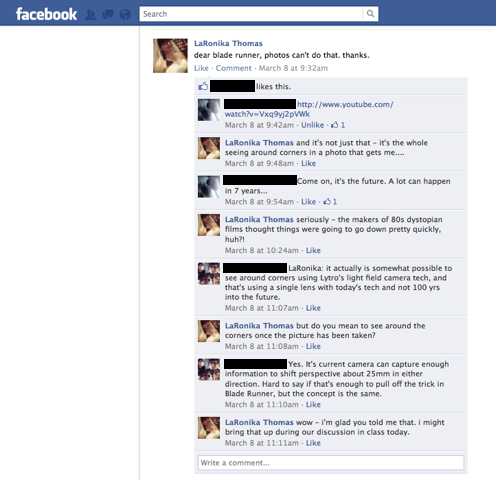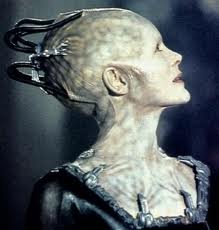Are Women Real?
In this post, I attempt to tie together many of the works we have discussed so far.
It wasn’t until I studied Frankenstein for the third time (with this class) that the issue of women and their status in society came to the forefront. I’m a little surprised I didn’t realize what was happening with the women in the novel before, but now that I have, I often find myself mulling the issue over, especially as it continues to resurface in many of our subsequent readings. One of the threads that connect the majority of works for me is how the status of women in society affects their “realness.” I find myself questioning the realness of the female characters in Frankenstein and it seems that Nathanael does the same in The Sandman. I thought this might an issue characteristic of the 19th centuries that could be solved by the passing of time, but the more contemporary works, Blade Runner and Patchwork Girl offer solutions that are ultimately not satisfying.
I don’t think any character in the novel questions whether or not Caroline Frankenstein, Elizabeth Lavenza, and Justine Moritz are real (as in human), but their lack of defining characteristics and their seemingly implicit death wishes do give them an unreal quality. In the novel, women are given as gifts that ultimately die untimely deaths. Caroline Frankenstein is the daughter of Mr. Beaufort, Alphonse Frankenstein’s close friend, and when Beaufort dies, his daughter is given to Alphonse. That’s a rather unsettling exchange. It’s not stated, but I imagine she was a teenager when her father died, and because her mother is not mentioned, I assume she’s also dead, so the only place for the orphaned Caroline is with her father’s best friend? I realize that marriages where there is a sizable age gap between the husband and wife were certainly more common in the late 18th century than present day, but that uncomfortable thought aside, Caroline had no choice in what her future would be. Elizabeth Lavenza is also given as a gift. She is the child of Alphonse’s sister and an Italian man. When her mother dies, her father remarries and gives his infant daughter to her uncle, and that is the last we hear of Mr. Lavenza. Elizabeth from her arrival in the Frankenstein family is promised to their son Victor. These two women seem simply to be items that are exchanged at the whim of men.
We don’t get any indication that Caroline is displeased by her fate from Victor’s description of her as a perfect domestic angel (so perfect that this interferes with Victor’s idea of women). However, I want to suggest that one of the reasons Caroline cared for Elizabeth when she was sick with scarlet fever is she didn’t actually care if she too caught the disease and died. Victor portrays this as another example of Caroline’s selflessness, but I think her weariness with her life can be detected in what she says. On her deathbed, Caroline gives her position to Elizabeth, “Elizabeth, my love, you must supply my place to your younger cousins” (26). Supply is an interesting word choice, it brings to mind the idea of production; Caroline is a producer of domesticity and can easily be replaced by a new producer, Elizabeth. Victor remarks on his cousin’s new role:
“Since the death of her aunt, her mind had acquired new firmness and vigour. She determined to fulfill her duties with the greatest exactness; and she felt that that most imperious duty, of rendering her uncle and cousins happy, had devolved upon her” (27) So Elizabeth’s reason for being is to make one man and three boys (Alphonse, Victor, Ernest, and William) happy.
The third unreal female character, Justine Moritz, does not begin her life or a marriage as a gift, but she is made to give the gift of her life. Because Justine seems completely resigned to die for a crime she didn’t commit, perhaps she too has realized that in the world in which she lives, her value is only in how she can serve men. Elizabeth is uncomplaining about her role of subservient caretaker and her death was the most sudden, so we don’t get her opinion on it, but maybe it was not only Victor who harbored a secret death wish for her? I do not believe she wished to die in the way she did, but I do not think it is too far a stretch to suggest that women welcome leaving the oppressive patriarchal society in which they live. Death does seem to be the only escape from a society where women are simply gifts, essentially domestic servants, no matter their station, and in every way, supplemental to men. Mary Shelley’s critique of patriarchal society is so strong and harsh, that I may yet be understating it.
The Sandman is a variation on the issue of realness. The main issue may be about Nathanael’s fear of his losing his eyes, the trauma this causes, and ultimately, whether Nathaneal is even a real human or not, but the issues concerning women are remarkably similar to those in Frankenstein. Whether or not Nathanael is real (I don’t think he is, but that’s another post entirely,) he is a proper patriarchal male in that he has a lot of trouble differentiating between the real and unreal women in the story: Clara, is a strong female, intelligent, sensible, and practical and Olympia who is nearly nonverbal, awkward, frequently referred to as stupid by her “father.” Nathanael, annoyed that Clara challenges his wild ideas, accuses Clara of being an automaton. That is quite an accusation to render on a person! A woman challenges a man must not be a human woman. I wonder how Victor would have responded if Elizabeth dared to challenge him? (She didn’t challenge him and he still did nothing to prevent her death, so imagine if she had been more aggressive!) Nathanael prefers to spend his time chattering away to Olympia, and he probably never would have realized she was an automaton had he not come upon Spalanzani and Coppola fighting over her lifeless (and eyeless) body. Nathanael’s preference for the subservient female who appears to be absorbed by all his ridiculous babbling makes complete sense in a patriarchal society. He thinks he has the issue sorted out, Clara is real and Olympia is not, but he once more becomes confused, tries to kill Clara, whom he is again convinced is an automaton, but he ends up killing himself. Perhaps this is a statement on how dangerous it is to buy into a society where woman are supplemental to men. There are other issues the lead to his death, but had Nathanael never been taken in by the false allure of Olympia, he may have resisted the Sandman.
The more modern works offer solutions to the issue of real/unreal women:
Blade Runner presents us with an alternate reality that curiously features no human women. This may be a solution: in an unchanging patriarchal society, women may need to take a different form to change society. Unfortunately, this futuristic reality is no different from the reality of Frankenstein or The Sandman. The two leading female characters, Rachael and Pris, are both replicants, and as such, must be “retired” to preserve humanity’s safety. Pris presents us with a different kind of female character, one who is aggressively sexual and acts to actively subvert the patriarchal society. Of course, she is not acting alone, but with (or, really it seems, under) Roy, and for me, that lessened her impact as a new kind of woman. It seemed as though she would likely follow any command that Roy gave her. Her aggressive sexuality does make her more dangerous and it is no shock that she is killed. Rachael, the one replicant who survives is naturally the most submissive, which in turn, makes her the most human. I found her character to be drawn much like the women in Frankenstein, beautiful, subservient, and uncomplaining. Rachael does seem sassy when she’s first introduced, but by the time Deckard has claimed her, that characteristic is all but gone. So, nothing has really changed from Frankenstein to Blade Runner:
In Patchwork Girl, the title character, who I find to be the most compelling female we’ve encountered thus far, is not truly a woman. The Patchwork Girl is a radical departure from the norms of patriarchic society, a girl made of man, woman, and animal sewn together. Perhaps she can change or at least break free from patriarchic society. The Patchwork Girl is charming, seductive, and the first female character that is truly independent, but she still isn’t fully a member of society because society has not changed. I think the Patchwork Girl is meant to be an example of a woman who breaks free from society be living outside of it, but as we see especially in her longing for Mary, this is often a lonely life. Despite that setback, the Patchwork Girl is the most fully realized of the female characters because she acknowledges her position and is able to surpass it. She is not able to change society but she is able to live independently, travel, escape the fate of being subservient to a man, and most important of all, she experiences the true friendship and true love with both Mary and Elsie, and these relationships are only possible between equals. (It may be argued that Alphonse and Caroline Frankenstein attained true love, but because Caroline is not his equal, I do not think the argument holds.) The Patchwork Girl accomplishes much, but for her to fully succeed, she would need to be accepted by society, and perhaps change it from within.
I’ve learned that being human is not enough to make women real in patriarchic society, and a woman has to be more than a gift, domestic servant, sexually aggressive threat, and so on, to be real.








